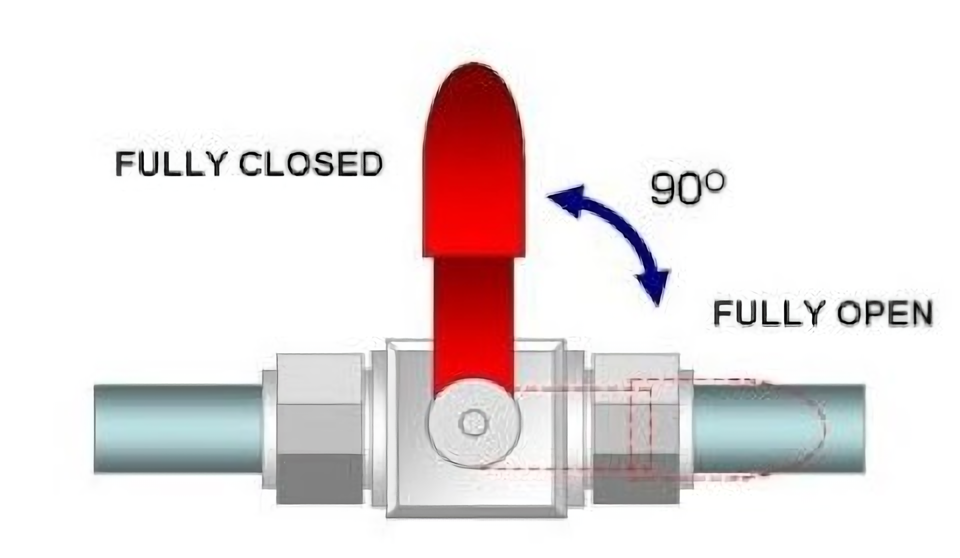Understanding whether a ball valve is open or closed is crucial for managing the flow of fluids in various applications, from domestic plumbing to industrial processes. Here, we’ll explore why it’s vital to read a ball valve correctly.

What Are Ball Valves
Ball valves are notorious for their simple yet effective design. These valves are typically operated by rotating a handle to a ball inside the valve. The ball has a hole, or port, that allows or blocks the flow of the medium when the valve is operated.
Features and characteristics of ball valves
Key features and characteristics of ball valves include:
- They provide a secure shut-off, controlling the flow of the medium
- They can support pressures up to 1000 bar and temperatures up to 482° F (250° C)
- Their operational life is long and reliable
How ball valves work
The functionality of a ball valve is pretty straightforward. The valve opens when the handle or lever is parallel to the pipe, and the medium can flow through. Analogously, when the handle is perpendicular to the pipe, the valve is closed, blocking the flow of the medium. This feature makes it easy to determine whether the valve is open or closed by simply looking at the position of the handle.
Why it’s important to know if a ball valve is open or closed
Decision-making in fluid management: Ball valves control fluid flow, a critical parameter in many operations. Thus, being wrong about a valve’s position can drastically affect the outcomes. For safe and efficient operation, it’s essential to determine whether the valve is open or closed accurately.
Next, we’ll scrutinize how to accurately determine the position of a ball valve, among other types. Stay tuned!
How to tell if ball valve is open or closed?
Identifying an Open Ball Valve
When evaluating a ball valve, it’s essential to understand the position of the handle that indicates whether the valve is open or closed.
Visual Indicators to Determine If a Ball Valve Is Open
A basic rule of thumb for ball valves is that the valve is open when the handle is aligned or paralleled to the pipe. The handle usually sits on top of the valve body and is attached to a ball inside. This interior ball has a hole, or port, through it. When the valve is open, the hole aligns with the direction of the pipeline flow.
Checking the Position of The Handle
Observe the handle: The valve is open if it is in the same orientation as the pipe. If the handle is perpendicular to the pipe, the valve is closed. This quick visual check can help you quickly and confidently identify whether your ball valve is open or closed and take the necessary actions.
Identifying a Closed Ball Valve
Ball valves are ingenious, utilizing a hollow ball inside the valve’s housing unit. The position of this ball determines whether the valve is open or closed.
Visual indicators to determine if a ball valve is closed
Recognizing a closed ball valve is relatively straightforward. The valve’s handle provides the most prominent visual indicator. When the given handle aligns perpendicularly (90° angle) to the pipe, it shows that the ball valve is closed.
Checking the position of the handle
To ascertain the position of the ball valve, check the handle. If the handle is parallel to the pipeline, the valve is open, and the water flow is allowed. However, if it is perpendicular, the valve is closed, halting the water flow. This straightforward design makes ball valves easy to operate and manage.
Other Methods to Determine Valve Status
Determining the status of a valve is crucial, especially in emergencies. Aside from visual cues, using a pressure gauge or flow meter and checking for water flow are reliable methods to tell if a valve is open or closed.
Using a pressure gauge or flow meter
A pressure gauge or flow meter can accurately measure the flow rate. The valve is likely closed if the reading is zero or below the standard rate.
Checking for water flow
If a faucet downstream of the valve does not release water when opened, it signifies that the valve upstream is closed.
Tips: In any case, it’s best to seek professional help if you’re unsure.
Benefits of Knowing Valve Status
Knowing whether your valves are open or closed is crucial for several reasons.
Preventing water leakage and damage:
Leak Prevention: An open valve can lead to unwanted water flow that could cause leaks or water damage. Merely knowing your valve’s status can save hefty repair costs down the line.
Improving efficiency and reducing water waste:
Eco-consciousness: Correctly managing your valves ensures maximum water efficiency, minimizing wastage, and contributing positively to the environment. Awareness is the first step to a greener home and a more sustainable world.
Conclusion
In conclusion, understanding whether your ball valve is open or closed can save you from potential disasters at home or in professional settings. If the handle of the valve is aligned with the route of the piping system, it signifies the valve is open and vice versa.
Importance of understanding how ball valves operate
It is vital to understand the functionalities of a ball valve to better control the flow within your pipeline and avoid unnecessary leakage and consequent damage. This knowledge enhances household management, reduces repair costs, and ensures a safe and efficient operating environment.












